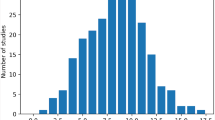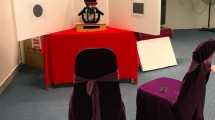Abstract
The development of sensorimotor coordination in infancy is fundamental for regulating interactional dynamics with peers and adults. In this work we present a multimodal device to systematically assess children’s orienting behavior in social situations. Technological choices are emphasized with respect to ecological requirements. Also ad-hoc calibration procedures are presented which are suitable to unstructured environments. Preliminary tests carried out at a local daycare with 12–36 months old typically developing infants prove the in-field usability of the proposed technology. Considerations on the future development of the device underscore the meaningful contribution that such platform can offer to child-robot interaction research.
Similar content being viewed by others
References
Aarabi P, Zaky S (2000) Iterative spatial probability based sound localization. In: Proceedings of the 4th world multiconference on circuits, systems, computers, and communications, Athens, Greece, July 2000
Aarabi P (1998) Multi-sense artificial awareness. MASc Thesis, Department of Electrical and Computer Engineering, University of Toronto, Ontario, Canada
Allison RS, Eiyenman M, Cheung BSK (1996) Combined head and eye. Tracking system for dynamic testing of the vestibular system. IEEE Trans Biomed Eng 43(11):1073–1082
Bates J (1994) The role of emotion in believable agents. Commun ACM 37(7):122–125
Billard A, Robins B, Dautenhahn K, Nadel J (2006) Building robota, a mini-humanoid robot for the rehabilitation of children with autism. RESNA Assist Technol J 19:37–49
Brandstein MS, Silverman H (1997) A robust method for speech signal time-delay estimation in reverberant rooms. In: Proceedings of the IEEE conference on acoustics, speech, and signal processing, Munich, Germany, April 1997
Campolo D, Laschi C, Keller F, Guglielmelli E (2007) A mechatronic platform for early diagnosis of neurodevelopmental disorders. RSJ Adv Robot J 21(10):1131–1150
Ceponiene R, Lepistö T, Shestakova A, Vanhala R, Alku P, Näätänen R, Yaguchi K (2003) Speech-sound-selective auditory impairment in children with autism: they can perceive but do not attend. Proc Nat Acad Sci USA 100(9):5567–5572
Crawford JD, Vilis T (1991) Axes of eye rotation and Listing’s law during rotations of the head. J Neurophysiol 65(3):407–423
Datum MS, Palmieri F, Moise A (1996) An artificial neural network for sound localization using binaural cues. J Acoust Soc Am 100(1):372–383
Dautenhahn K, Werry I (2000) Issues of robot-human interaction dynamics in the rehabilitation of children with autism
Dautenhahn K (1999) Robots as social actors: Aurora and the case of autism. In: Proceedings CT 99, the third international cognitive technology conference, August, San Francisco, pp 359–374
Dautenhahn K, Werry I (2004) Towards interactive robots in autism therapy. Pragmat Cogn 12:1–35
Davis A, Bamford J, Wilson I, Ramkalawan T, Forshaw M, Wright S (1997) Health. A critical review of the role of neonatal hearing screening in the detection of congenital hearing impairment. Health Technol Assess 1:1–176
Dawson G, Meltzoff AN, Osterling J, Rinaldi J, Brown E (1998) Children with autism fail to orient to naturally occurring social stimuli. J Autism Dev Disord 28:479–485
Dawson G, Toth K, Abbott R, Osterling J, Munson J, Estes A, Liaw J (2004) Early social attention impairments in autism: social orienting, joint attention, and attention to distress. Dev Psychol 40(2):271–283
DiScenna A, Das V, Zivotofsky A, Seidman S, Leigh RJ (1995) Evaluation of a video tracking device for measurement of horizontal and vertical eye rotations during locomotion. J Neurosci Methods 58(1–2):89–94
Dongheng Li, Babcock J, Parkhurst DJ (2006) OpenEyes: a low-cost head-mounted eye-tracking solution. In: Proceedings of the 2006 symposium on eye tracking research and application, San Diego, California, pp 95–100
Kanda T, Ishiguro H, Ishida T (2001) Psychological analysis on human-robot interaction. In: Int conf on robotics and automation (ICRA 2001), pp 4166–4173
Kanda T, Ishiguro H, Imai M, Ono T (2003) Body movement analysis of human-robot interaction. In: International joint conference on artificial intelligence, IJCAI, pp 177–182
Kemp DT (1978) Stimulated acoustic emissions from within the human auditory system. J Acoust Soc Am 64:1386–1391
Kendon A (1970) Movement coordination in social interaction: some examples described. Acta Psychol 32:100–125
Kipp M (2001) Anvil-a generic annotation tool for multimodal dialogue. In: Proceedings of the 7th European conference on speech communication and technology, Eurospeech, September 2001, pp 1367–1370
Knapp CH, Carter G (1976) The generalized correlation method for estimation of time delay. IEEE Trans Acoust Speech Signal Process 24(4):320–327
Koide Y, Kanda T, Sumi Y, Kogure K, Ishiguro H (2004) An approach to integrating an interactive guide robot with ubiquitous sensors. In: IEEE/RSJ international conference on intelligent robots and systems, IROS, 28 September–2 October 2004, Sendai, Japan
Kozima H, Nakagawa C, Yasuda Y, Kosugi D (2004) A toy-like robot in the playroom for children with developmental disorder. In: Proceedings of the international conference on development and learning, San Diego, CA
Kozima H (2002) Infanoid: a babybot that explores the social environment. In: Dautenhahn K et al (eds) Socially intelligent agent. Kluwer Academic, Dordrecht, pp 157–164
Kozima H, Nakagawa C (2007) Longitudinal child-robot interaction at preschool. In: AAAI spring symposium on multidisciplinary collaboration for socially assistive robotics, March 2007, pp 27–32
Kozima H, Nakagawa C (2007) Interactive robots as facilitators of children’s social development. In: Lazinica A (ed) Mobile robots: towards new applications, Vienna: advanced robotic systems, pp 269–286
Lepisto T, Kujala T, Vanhala R, Alku P, Huotilainen M, Näätänen R (2005) The discrimination of and orienting to speech and non-speech sounds in children with autism. Brain Res 1066:147
Lord C, Rutter ML, Goode S, Heemsbergen J (1989) Autism diagnostic observation schedule: a standardized observation of communicative and social behavior. J Autism Dev Disord 19:185–212
Mungamuru B, Aarabi P (2004) Enhanced sound localization. IEEE Trans Syst Man Cybern B: Cybern 34(3):1526–1540
Ogata T, Sugano S (1999) Emotional communication between humans and the autonomous robot which has the emotion model. In: IEEE int conf on robotics and automation (ICRA’99), pp 3177–3182
Ornitz EM, Kaplan AR, Westlake JR (1985) Developmet of the vestibule-ocular reflex from infancy to adulthood. Acta Otolaryngol 100:180–193
Picardi L, Noris B, Schiavone G, Keller F, Von Hofsten C, Billard AG (2007) In: RO-MAN’07: proceedings of the 16th international symposium on robot and human interactive communication
Plaisant C, Druin A, Lathan C, Dakhane K, Edwards K, Vice JM, Montemayor J (2000) A storytelling robot for pediatric rehabilitation. In: Proceedings of ASSETS’2000, Washington DC, Nov 2000. ACM, New York
Reidsma D, Jovanovic N, Hofs D (2005) Designing annotation tools based on properties annotation problems. In: Measuring behavior 2005, 5th int conf on methods and techniques in behavioral research, 30 August–2 September 2005
Robinson DA (1963) A method of measuring eye movements using a scleral search coil in a magnetic field. IEEE Trans Biomed Electron BME 10:137–145
Robins B, Dautenhahn K, Dickerson P, Stribling P (2004) Robot mediated joint attention in children with autism. Interact Stud 5:161–198
Robins B, Dautenhahn K, Nehaniv CL, Mirza NA, Francois D, Olsson L (2005) Sustaining interaction dynamics and engagement in dyadic child-robot interaction kinesics: lessons learnt from an exploratory study. In: Proc. IEEE RO-MAN’05. IEEE Press, New York, pp 716–722
Robins B, Dautenhahn K, te Boekhorst R, Billard A (2005) Robotic assistants in therapy and education of children with autism. Univ Access Inform Soc 4(2):105–120
Robins B, Dickerson P, Dautenhahn K (2005) Robots as embodied beings—interactionally sensitive body movements in interactions among autistic children and a robot. In: 14th IEEE international workshop on robot and human interactive communication, RO-MAN05, Nashville, USA
Rutherford MD, Baron-Cohen S, Wheelwright S (2002) Reading the mind in the voice: a study with normal adults and adults with asperger syndrome and high functioning autism. J Autism Dev Disord 32(3):189–194
Salter T, Michaud F, Dautenhahn K, Letourneau D, Caron S (2005) Recognizing interaction from a robot’s perspective. In: IEEE international workshop on robot and human interactive communication, ROMAN, 2005, pp 178–183
Salter T, Michaud F, Larouche H (2010) How wild is wild? A taxonomy to characterize the ‘wildness’ of child-robot interaction. Int J Soc Robot. Published online: 11 August 2010
Scassellati B (2005) Quantitative metrics of social response for autism diagnosis. In: Proc. ROMAN
Schiavone G, Campolo D, Keller F, Guglielmelli E (2009) Calibration of a multimodal head-mounted device for ecological assessment of social orienting behavior in children. In: The 2009 IEEE/RSJ international conference on intelligent robots and systems, Hyatt Regency, St Louis, USA, Oct 11–15
Sigman MD, Kasari C, Kwon JH, Yirmiya N (1992) Responses to the negative emotions of others by autistic, mentally retarded, and normal children. Child Dev 63:796–807
Liu T, Inoue Y, Shibata K (2006) A wearable sensor system for human motion analysis and humanoid robot control. In: IEEE international conference on robotics and biomimetics, ROBIO’06, 17–20 Dec 2006, pp 43–48
Volkmar FR, Chawarska K, Klin A (2005) Autism in infancy and early childhood. Ann Rev Psychol 56:315–336
Watanabe H, Suzuki M, Nagai N, Miki N (1989) A method for maximum likelihood bearing estimation without nonlinear maximization. Trans Inst Electron Inf Commun Eng J72A(8):303–308
Welch G, Foxlin E (2002) Motion tracking: no silver bullet, but a respectable arsenal, motion tracking survey. IEEE Comput Graph Appl 22(6):24–38
Welch KC, Lahiri U, Warren Z, Sarkar N (2010) An approach to the design of socially acceptable robots for children with autism spectrum disorders. Int J Soc Robot. Published online: 07 July 2010
Werry I, Dautenhahn K, Ogden B, Harwin W (2001) Can social interaction skills be taught by a social agent. The role of a robotic mediator in autism therapy. In: Beynon M, Nehaniv CL, Dautenhahn K (eds) Cognitive technology: instruments
Winfield D, Li D, Babcock J, Parkhurst DJ (2005) Towards an open-hardware open-software toolkit for robust low-cost eye tracking in HCI applications. Iowa State University, Human Computer Interaction Technical Report ISU-HCI, April 2005
Author information
Authors and Affiliations
Corresponding author
Additional information
This work was partly supported by a grant from the European Union, TACT (Thought in Action), FP6-NEST/ADVENTURE program, contract no. 015636 and by the Academic Research Fund (AcRF) Tier1 (RG 40/09), Ministry of Education, Singapore.
Rights and permissions
About this article
Cite this article
Schiavone, G., Formica, D., Taffoni, F. et al. Multimodal Ecological Technology: From Child’s Social Behavior Assessment to Child-Robot Interaction Improvement. Int J of Soc Robotics 3, 69–81 (2011). https://doi.org/10.1007/s12369-010-0080-9
Accepted:
Published:
Issue Date:
DOI: https://doi.org/10.1007/s12369-010-0080-9




